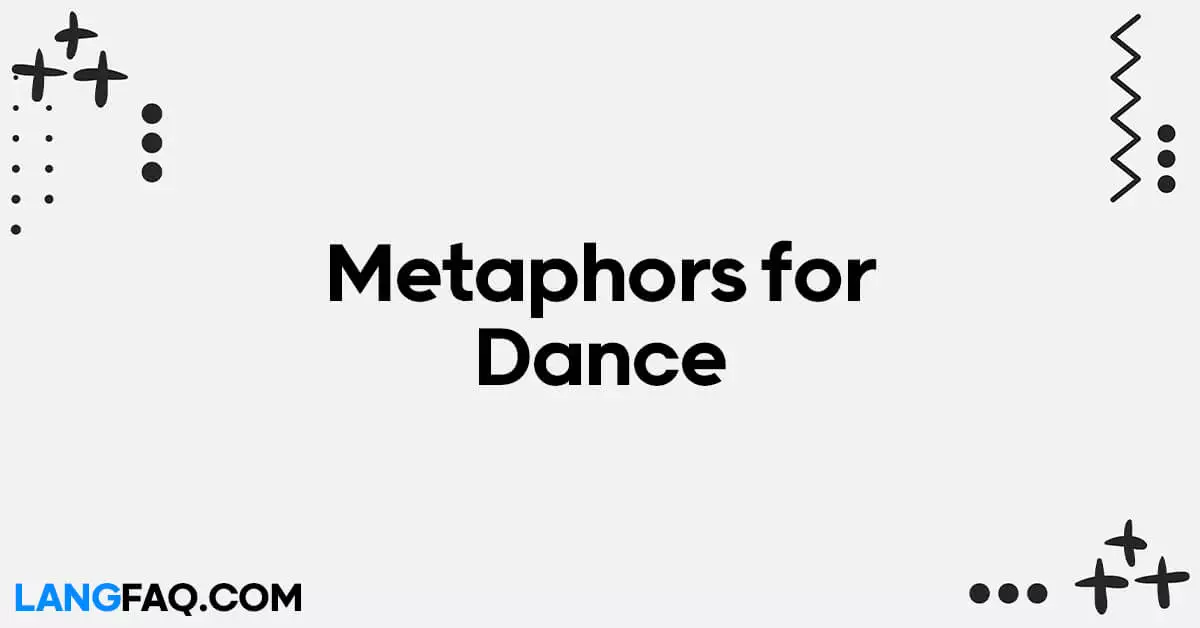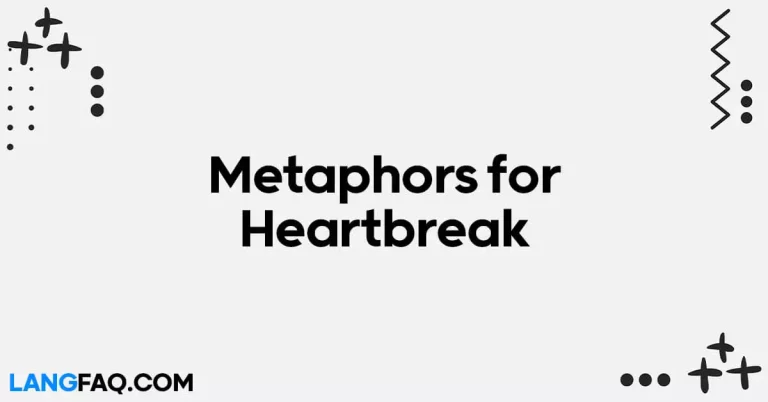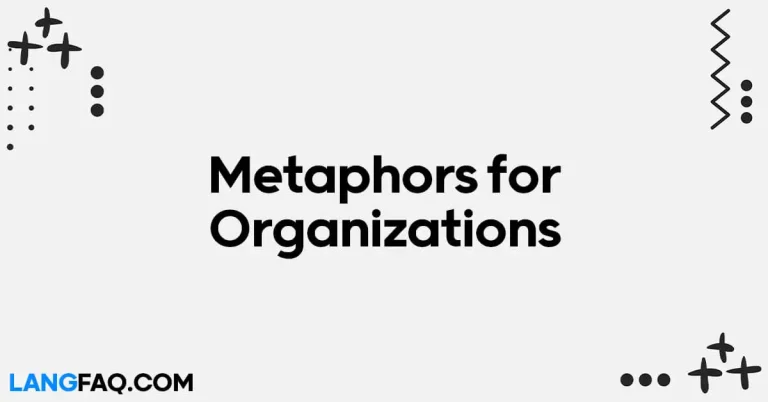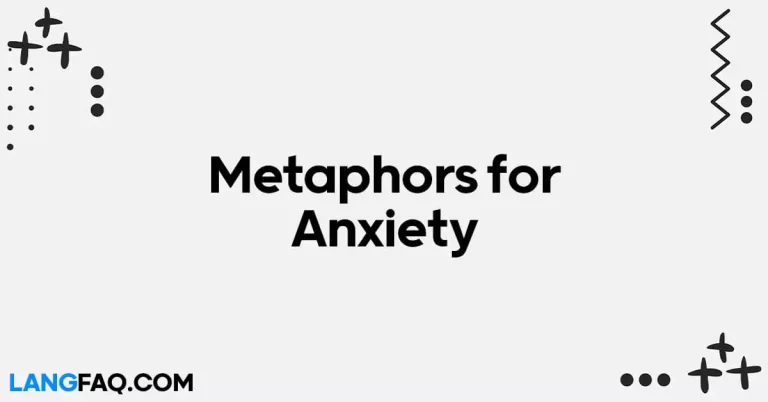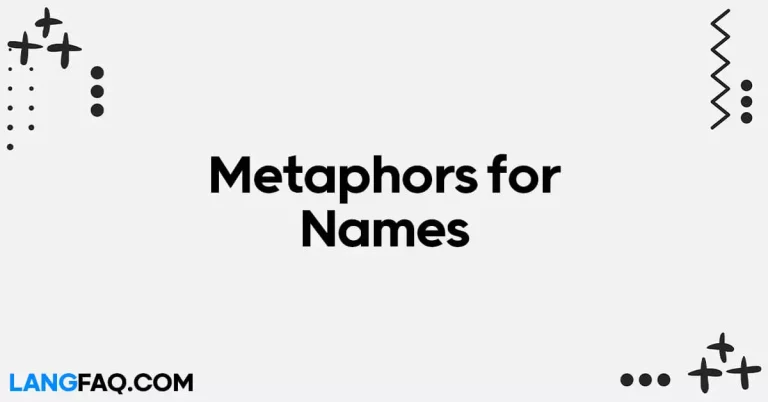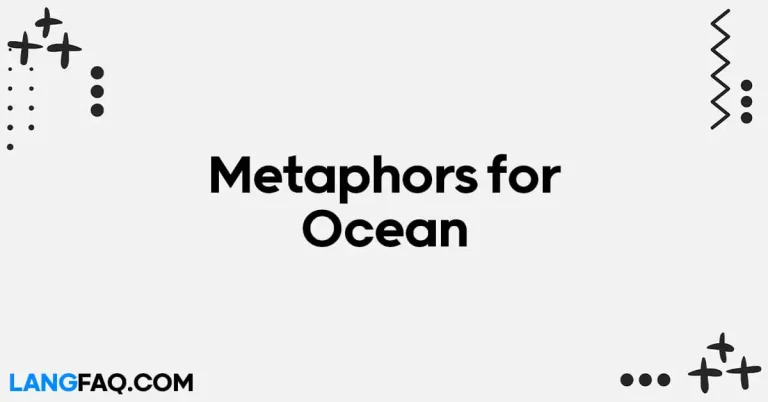Dance has always been a profound form of expression, a universal language that speaks to our hearts and souls. It’s a captivating art form that has the power to convey emotions, stories, and cultural traditions.
To truly appreciate the beauty of dance, we can explore it through metaphors, comparing it to various aspects of life.
In this article, we will delve into 26 metaphors for dance, each shedding light on a different facet of this enchanting art.
26 Metaphors for Dance
- Dance is a Symphony of Emotions: Like a conductor guiding an orchestra, dance orchestrates emotions into a beautiful composition.
- Dance is Poetry in Motion: Each step and movement is a verse, creating a visual poem on the stage.
- Dance is a Conversation with Gravity: Dancers defy gravity with every leap and twirl, engaging in a graceful dialogue.
- Dance is an Expression of Freedom: It allows individuals to break free from constraints and express themselves through movement.
- Dance is a Painter’s Brushstroke: The dancer’s body becomes a brush, and the stage a canvas where vibrant images are painted.
- Dance is a Cultural Mosaic: It reflects the diversity of cultures, weaving together traditions and stories.
- Dance is a Celebration of Life: It marks life’s milestones, from birth to marriage, with joyful movements.
- Dance is a Healing Rhythm: Movement in dance can heal both the body and the soul, providing solace and joy.
- Dance is a Sculptor’s Masterpiece: Dancers sculpt their bodies to perfection, like a sculptor shaping marble.
- Dance is a Storyteller’s Tale: Every dance performance tells a story, conveying emotions and narratives.
- Dance is a Mirror of Nature: It can imitate the gentle sway of leaves in the wind or the power of a thunderstorm.
- Dance is a Bridge Between Generations: It passes down traditions and cultural heritage, connecting generations.
- Dance is a Reflection of Society: Dance often reflects societal values, provoking thought and change.
- Dance is a Collaborative Poetry: In group dances, dancers contribute verses to a harmonious poem.
- Dance is a Journey Within: Dancers explore their emotions, fears, and aspirations through movement.
- Dance is a Breath of Life: It infuses life with vitality, becoming an essential part of existence.
- Dance is a Kaleidoscope of Emotions: It weaves together a myriad of emotions into a captivating performance.
- Dance is a Poignant Memory: Special moments in life, like a first dance at a wedding, become cherished memories.
- Dance is a Heartbeat of Unity: In a dance ensemble, dancers move in unison, creating a powerful sense of unity.
- Dance is an Echo of Dreams: Dreams take flight in dance, as dancers reach for the stars with each leap.
- Dance is a Confluence of Art Forms: It combines music, visual art, and storytelling into a creative masterpiece.
- Dance is a Timeless Tradition: Passed down through generations, it retains its timeless essence.
- Dance is a Source of Inspiration: Watching a mesmerizing dance performance can inspire creativity and passion.
- Dance is the Poetry of the Soul: Ultimately, dance is the poetry of the soul, expressing the deepest truths of the human experience.
These metaphors capture the essence and beauty of dance in various ways, showcasing its versatility and significance.
| Metaphor | Meaning | Example |
|---|---|---|
| Symphony of Emotions | Dance is a composition of emotions. | The ballet performance was a symphony of emotions, with each move conveying a different feeling. |
| Poetry in Motion | Dance is a visual poem. | Her contemporary dance was like poetry in motion, with every step telling a story. |
| Conversation with Gravity | Dancers seem to defy gravity. | The ballerina’s graceful leaps appeared as a conversation with gravity itself. |
| Expression of Freedom | Dance is a form of liberation. | The expressive dance allowed the performer to experience a profound sense of freedom. |
| Painter’s Brushstroke | The dancer’s body becomes a brush. | His hip-hop moves resembled a painter’s energetic brushstrokes on the dance floor. |
| Cultural Mosaic | Dance reflects diverse cultures. | The multicultural dance festival showcased a vibrant cultural mosaic of traditions. |
| Celebration of Life | Dance marks life’s milestones. | The wedding dance was a celebration of their love and the beginning of a new life together. |
| Healing Rhythm | Dance has therapeutic qualities. | Dance therapy uses movement as a healing rhythm to promote emotional well-being. |
| Sculptor’s Masterpiece | Dancers sculpt their bodies. | The ballet dancer’s physique was a sculptor’s masterpiece, finely chiseled and elegant. |
| Storyteller’s Tale | Every dance performance tells a story. | The contemporary dance piece was a storyteller’s tale of love, loss, and redemption. |
| Mirror of Nature | Dance imitates natural elements. | The modern dance piece beautifully mirrored the gentle flow of a river through graceful movements. |
| Bridge Between Generations | Dance connects past and future. | Traditional folk dances serve as a bridge between generations, preserving cultural heritage. |
| Reflection of Society | Dance reflects societal values. | The choreography of the dance troupe was a reflection of contemporary societal issues. |
| Collaborative Poetry | Group dances create a harmonious poem. | The synchronized movements of the dance troupe were like lines of collaborative poetry on stage. |
| Journey Within | Dancers explore their inner selves. | Through contemporary dance, she embarked on a personal journey within, discovering her true emotions. |
| Breath of Life | Dance infuses life with vitality. | The traditional dance at the festival brought a breath of life to the entire event, energizing the audience. |
| Kaleidoscope of Emotions | Dance weaves together diverse emotions. | The dance performance was a kaleidoscope of emotions, ranging from joy to sorrow to excitement. |
| Poignant Memory | Dance creates cherished memories. | The father-daughter dance at the wedding became a poignant memory for the entire family. |
| Heartbeat of Unity | Group dances create a sense of unity. | The synchronized dance routine became the heartbeat of unity for the team, strengthening their bond. |
| Echo of Dreams | Dance symbolizes the pursuit of dreams. | The contemporary dance piece was an echo of dreams, with dancers reaching for the stars in each move. |
| Confluence of Art Forms | Dance combines various art forms. | Contemporary dance is a confluence of art forms, blending music, visual art, and storytelling. |
| Timeless Tradition | Dance traditions endure through time. | Classical ballet is a timeless tradition that has been passed down for generations. |
| Source of Inspiration | Dance inspires creativity and passion. | The mesmerizing dance performance served as a source of inspiration for aspiring dancers in the audience. |
| Poetry of the Soul | Dance expresses the deepest truths. | The contemporary solo was a poetry of the soul, baring the dancer’s innermost emotions and thoughts. |
These examples illustrate how each metaphor captures a unique facet of dance, making it a rich and expressive art form.
Dance is a Symphony of Movement
Meaning: The metaphor “Dance is a Symphony of Movement” highlights the idea that dance choreography resembles the complex composition of a symphony. Just as different instruments in an orchestra come together to create harmonious music, dancers blend various movements and steps to create a beautiful and coordinated dance performance.
Usage: This metaphor can be used in both formal and informal contexts when discussing dance. It’s particularly effective when you want to emphasize the coordinated and harmonious aspects of dance.
Example in a Formal Context: In a dance critique:
“The ballet performance showcased the seamless coordination of dancers, truly exemplifying dance as a symphony of movement. Each dancer’s contribution was like a musical note in a well-composed symphony.”
Example in an Informal Context: In a conversation with a friend:
Friend: “I watched a contemporary dance show last night.” You: “Oh, contemporary dance is fascinating! It’s like a symphony of movement, where every dancer contributes to the overall harmony.”
Related Phrases:
- Dance as Coordinated Expression
- Movement as Choreographic Harmony
Pros:
- Evokes an image of harmony and coordination in dance.
- Emphasizes the idea that dance is a collective art form.
Cons:
- Avoid overusing this metaphor, as it may become cliché if used too frequently.
Tips:
- Use this metaphor when discussing the synchronization and coordination of dance performances.
Dance is a Language of the Body
Meaning: The metaphor “Dance is a Language of the Body” suggests that dance serves as a means of communication and expression. Just as spoken and written language conveys thoughts and emotions, dance movements and expressions convey messages and feelings through the body.
Usage: This metaphor is versatile and can be used in various contexts, both formal and informal, to emphasize the communicative and expressive aspects of dance.
Example in a Formal Context: In a dance workshop description:
“Join our contemporary dance workshop to explore the language of the body. Learn how movements and gestures can convey powerful messages and emotions.”
Example in an Informal Context: In a social media post:
“Attending a salsa dance class tonight! Salsa is all about the language of the body, where every step tells a story of passion and rhythm.”
Related Phrases:
- Dance as Expressive Communication
- Movement as Emotional Expression
Pros:
- Highlights the expressive and communicative power of dance.
- Suitable for discussions on the emotional depth of dance.
Cons:
- Ensure that the context aligns with the metaphor, as it may not suit technical discussions of dance techniques.
Tips:
- Use this metaphor when discussing the ability of dance to convey emotions, stories, and messages.
Dance is a Kaleidoscope of Rhythms
Meaning: The metaphor “Dance is a Kaleidoscope of Rhythms” conveys the idea that dance encompasses a diverse array of styles, beats, and patterns, much like the ever-changing patterns in a kaleidoscope. Each dance style is unique and captivating in its own way.
Usage: This metaphor is effective in both formal and informal contexts when discussing the diversity and richness of dance styles and rhythms.
Example in a Formal Context: In an article about the history of dance:
“Dance throughout history has been a kaleidoscope of rhythms, with each era and culture contributing to the vibrant tapestry of dance forms we see today.”
Example in an Informal Context: In a conversation with a dance enthusiast:
Friend: “I’m thinking of taking up hip-hop dance.” You: “That’s a fantastic idea! Hip-hop is like a kaleidoscope of rhythms, where you can explore various styles and beats.”
Related Phrases:
- Dance as Rhythmic Diversity
- Movement as Dance Tapestry
Pros:
- Celebrates the diversity of dance styles and cultures.
- Suitable for discussions about exploring different dance genres.
Cons:
- Ensure that the metaphor aligns with the context; it may not be the best choice for highly technical discussions.
Tips:
- Use this metaphor when highlighting the variety and richness of dance forms.
Dance is a Tapestry of Emotions
Meaning: The metaphor “Dance is a Tapestry of Emotions” emphasizes the idea that dance can convey a wide range of feelings and emotions through movements and expressions. Each dance performance weaves together a complex and colorful tapestry of emotional experiences.
Usage: This metaphor is versatile and can be used in both formal and informal contexts to discuss the emotional depth and richness of dance.
Example in a Formal Context: In a dance review:
“The contemporary dance piece was a masterpiece, intricately weaving together a tapestry of emotions, from love and joy to sorrow and introspection.”
Example in an Informal Context: In a conversation with a fellow dance lover:
Friend: “I watched a ballet performance last night.” You: “Ballet is amazing! It’s like a tapestry of emotions where every movement tells a different part of the emotional story.”
Related Phrases:
- Dance as Emotional Expression
- Movement as Feelings Unveiled
Pros:
- Highlights the emotional depth and storytelling aspect of dance.
- Suitable for discussions about the evocative power of dance.
Cons:
- Ensure that the context aligns with the metaphor, as it may not be suitable for technical discussions.
Tips:
- Use this metaphor when discussing how dance conveys a wide range of emotions and feelings.
Dance is a Journey Through Time
Meaning: The metaphor “Dance is a Journey Through Time” suggests that dance allows us to explore different eras, cultures, and stories through movement. Each dance style carries with it a piece of history and a unique narrative.
Usage: This metaphor can be used in both formal and informal contexts when discussing the historical and cultural significance of dance styles.
Example in a Formal Context: In an academic paper on traditional dance forms:
“Traditional dance forms provide a fascinating journey through time, offering insights into the cultural heritage and historical context of different regions.”
Example in an Informal Context: In a chat with a friend:
Friend: “I’m learning the waltz for a wedding.” You: “That’s wonderful! The waltz is like a journey through time, with each step echoing the elegance and history of ballroom dance.”
Related Phrases:
- Dance as Historical Exploration
- Movement as Cultural Heritage
Pros:
- Emphasizes the historical and cultural aspects of dance.
- Suitable for discussions about the significance of dance in preserving traditions.
Cons:
- Ensure that the metaphor aligns with the context; it may not be suitable for purely technical discussions.
Tips:
- Use this metaphor when discussing how dance connects us to different time periods and cultural legacies.
Frequently Asked Questions
Q: How can I learn to dance using these metaphors?
Learning to dance using metaphors can be a creative and enjoyable experience. Each metaphor can inspire you to explore different aspects of dance, such as emotions, storytelling, or cultural connections. Consider taking dance classes or workshops that focus on these metaphors, and don’t be afraid to express yourself through movement.
Q: Are there specific dance styles associated with these metaphors?
While some metaphors may align with certain dance styles, the beauty of dance is its versatility. You can apply these metaphors to various dance forms, from ballet and contemporary dance to hip-hop and traditional folk dances. The key is to let your creativity flow and find the connection between the metaphor and your chosen dance style.
Q: How can I use dance metaphors to enhance my choreography?
Incorporating dance metaphors into your choreography can add depth and meaning to your performances. Start by selecting a metaphor that resonates with the theme or emotion you want to convey. Then, use it as a guiding principle for your movements, expressions, and storytelling. This will help create a more compelling and memorable dance piece.
Q: What role do metaphors play in dance therapy?
Metaphors play a significant role in dance therapy, as they can help individuals explore and express their emotions. Therapists often use dance metaphors to guide clients in understanding their feelings, overcoming challenges, and promoting healing. It’s a powerful tool for self-discovery and emotional well-being.
Q: Can dance metaphors be used in storytelling through dance?
Absolutely! Dance is a potent storytelling medium, and metaphors can enhance the narrative. By incorporating metaphors into your choreography and performance, you can create a compelling story that resonates with the audience on a deeper level. It adds layers of meaning and emotion to your dance storytelling.
Q: Where can I watch performances that embody these dance metaphors?
You can experience dance performances that embody these metaphors by attending live dance shows, visiting dance studios, or watching online dance videos. Look for performances that align with the specific metaphor you’re interested in exploring. You’ll be amazed at how dancers bring these metaphors to life on stage.
Conclusion
Dance is a magical journey that transcends words and speaks directly to the soul. Through these 26 metaphors, we have explored the multifaceted nature of dance, from its role as a storyteller to its power as a healing art. Whether you’re a dancer, a dance enthusiast, or simply someone who appreciates the beauty of movement, may these metaphors inspire you to embrace the poetry of dance in all its forms.

